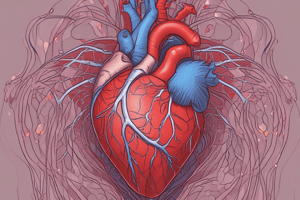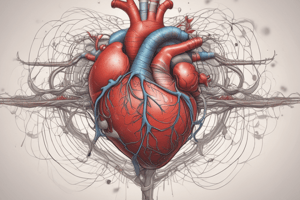Podcast
Questions and Answers
Flashcards
Anatomy of the heart
Anatomy of the heart
The heart is a hollow, muscular organ in the thorax, between lungs, resting on the diaphragm.
Layers of the heart
Layers of the heart
The heart has three layers: endocardium (inner), myocardium (middle), and epicardium (outer).
Heart chambers
Heart chambers
The heart has four chambers: two atria (top) and two ventricles (bottom) for pumping blood.
Heart valves
Heart valves
Signup and view all the flashcards
Coronary arteries
Coronary arteries
Signup and view all the flashcards
Myocardial ischemia
Myocardial ischemia
Signup and view all the flashcards
Sinoatrial node
Sinoatrial node
Signup and view all the flashcards
Atrioventricular node
Atrioventricular node
Signup and view all the flashcards
Bicuspid Valve
Bicuspid Valve
Signup and view all the flashcards
Pulmonic Valve
Pulmonic Valve
Signup and view all the flashcards
ECG readings
ECG readings
Signup and view all the flashcards
Heart failure symptoms
Heart failure symptoms
Signup and view all the flashcards
Ejection fraction
Ejection fraction
Signup and view all the flashcards
Angina pectoris
Angina pectoris
Signup and view all the flashcards
Atherosclerosis
Atherosclerosis
Signup and view all the flashcards
Myocardial infarction
Myocardial infarction
Signup and view all the flashcards
Beta-blockers
Beta-blockers
Signup and view all the flashcards
Diuretics
Diuretics
Signup and view all the flashcards
Risk factors for CAD
Risk factors for CAD
Signup and view all the flashcards
Stroke symptoms
Stroke symptoms
Signup and view all the flashcards
Pulmonary embolism
Pulmonary embolism
Signup and view all the flashcards
Cardiac tamponade
Cardiac tamponade
Signup and view all the flashcards
Heart valves conditions
Heart valves conditions
Signup and view all the flashcards
Hypertension
Hypertension
Signup and view all the flashcards
Anemia symptoms
Anemia symptoms
Signup and view all the flashcards
Iron deficiency
Iron deficiency
Signup and view all the flashcards
Vitamin B12 deficiency
Vitamin B12 deficiency
Signup and view all the flashcards
Transfusion reaction
Transfusion reaction
Signup and view all the flashcards
Study Notes
CARDIOVASCULAR SYSTEM
- The heart is a hollow, muscular organ located in the center of the thorax, between the lungs (mediastinum), resting on the diaphragm.
- The heart has three layers:
- Endocardium (inner layer) - endothelial tissue lining the heart and valves.
- Myocardium (middle layer) - made up of muscle fibers responsible for pumping action.
- Epicardium (outer layer).
- The pericardium is a thin, fibrous sac that encases the heart.
- The heart has four chambers: two atria (top chambers) and two ventricles (bottom chambers), enabling rhythmic contraction and relaxation. This rhythmic activity pumps blood.
- Heart valves regulate one-way blood flow:
- Atrioventricular (AV) valves separate the atria from the ventricles.
- Semilunar valves have three leaflets and shape like a half-moon; they close during diastole.
- Coronary arteries supply oxygenated blood to the heart. Perfusion occurs during diastole.
- Myocardium is the middle muscular layer of the atrial and ventricular walls, comprising specialized cells (myocytes).
- ECG readings monitor electrical activity.
- Bicuspid valve separates the right and left atria; Sinoatrial node is at the juncture of the superior vena cava and the right atrium. Parietal Pericardium supports the heart in the mediastinum.
SITUATIONAL QUESTIONS (CHAPTER 21)
- Pericarditis is an inflammation of the thin sac-like membrane surrounding the heart. Inflammation is located in the thin fibrous sac encasing the heart.
- The nurse documents an abnormal heart sound that is detected during the early diastole as an S3. The apical pulse is located in the left fifth intercostal space at the midclavicular line when a patient is in normal position. Heart rate of 140 bpm may suggest the complication of myocardial ischemia, pulmonary embolism or right-sided heart failure.
- Beta-blocker medication is used to lower automaticity.
SITUATIONAL QUESTIONS (CHAPTER 21) cont.
- Which structure of the heart contains the AV node? Right atrial wall near the tricuspid valve.
- If the ejection fraction is 35%, the nurse would anticipate myocardial infarction as the potential issue.
SITUATIONAL QUESTIONS (CHAPTER 21) cont.
- Nonmodifiable risk factors for atherosclerosis include obesity, positive family history, and hyperlipidemia.
- Pulse pressure is the difference between systolic and diastolic blood pressure.
- A 10 mm HG increase in systolic blood pressure over baseline is a significant finding related to orthostatic vital signs.
- A certified nurse assistant using a blood pressure cuff that is too small for the patient may falsely decrease the reading.
SITUATIONAL QUESTIONS (CHAPTER 21) cont.
- Estrogen replacement therapy is not a recommended therapy for reducing the risk of atherosclerosis.
- An abnormal heart sound like S3 is heard during the early portion of the diastole.
- The apical pulse would be found in the left fifth intercostal space at the midclavicular line.
- Nursing interventions for a patient with a heart rate of 140 bpm will be focused on monitoring for the complications including myocardial ischeamia, pulmonary embolism or right-sided heart failure.
SITUATIONAL QUESTIONS (CHAPTER 22) cont.
- Sinus tachycardia is a rapid heart rate originating from the sinoatrial node.
- Normal sinus rhythm involves a regular rhythm and a rate between 60-100bpm.
- The nurse monitors the patients for atrial fibrillation, atrial flutter, ventricular tachycardia, and ventricular fibrillation, after a coronary artery bypass graft (CABG).
- In a patient with a rhythm of 140 bpm, the nurse should closely monitor the patient for complications, including myocardial ischemia, pulmonary embolism and right ventricular heart failure. Also, perform CPR if the patient has a sudden cardiac arrest.
SITUATIONAL QUESTIONS (CHAPTER 23) cont.
- The patient may experience decreased automaticity in the heart, after a beta-blocker administration.
- The impulse originates from the sinoatrial node.
- The resting phase before depolarization is known as phase 4.
- A diagnosis of ejection fraction of 35% suggests treatment for myocardial infarction.
- The nurse monitors patients for angina, myocardial infarction, pulmonary embolism, pericarditis, and heart failure.
- Nonmodifiable risk factors for atherosclerosis include age, gender, ethnicity, and family history.
SITUATIONAL QUESTIONS (CHAPTER 22) cont.
- Cocaine use can lead to chest pain.
- Correct rhythm for systolic blood pressure 140/92.
- The nurse will first provide CPR in a patient with flat line on the monitor in an emergency situation,
- The normal pulse would be found in the left fifth intercostal space.
GENERAL INFORMATION
- Atrial fibrillation: irregular ventricular rate, rapid, "sawtooth" P-waves.
- Atrial flutter: an irregular ventricular rate, repetitive pattern, "sawtooth" P-waves.
- Ventricular tachycardia: rapid ventricular rate, often irregular, wide QRS complex.
- Ventricular fibrillation: irregular, chaotic ventricular rhythm.
- Treatment for arrhythmias depends on the type and may involve medication, cardioversion, defibrillation, pacemaker insertion, or ICD implantation. Cardiac rhythms need to be monitored.
Studying That Suits You
Use AI to generate personalized quizzes and flashcards to suit your learning preferences.




